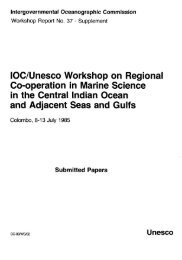Manual on sea level measurement and ... - unesdoc - Unesco
Manual on sea level measurement and ... - unesdoc - Unesco
Manual on sea level measurement and ... - unesdoc - Unesco
- No tags were found...
You also want an ePaper? Increase the reach of your titles
YUMPU automatically turns print PDFs into web optimized ePapers that Google loves.
Sea Level Measurement <strong>and</strong> Interpretati<strong>on</strong>For this timing correcti<strong>on</strong>, the reference was of coursethe Geónica <strong>sea</strong> <strong>level</strong> series, as it was the <strong>on</strong>ly <strong>on</strong>e withGPS assignment of time during the experiment. Table1 shows the RMS errors of comparis<strong>on</strong>s for each pairof sensors after adjustment for time. These range from0.7 cm (corresp<strong>on</strong>ding to Geónica <strong>and</strong> Seba, whichis reas<strong>on</strong>able, since they use the same type of radarsensor) <strong>and</strong> 1.9 cm (Aquatrak <strong>and</strong> Miros, mainly dueto an effect of temperature <strong>on</strong> the Aquatrak beinghigher than expected <strong>and</strong> not corrected). These valuesdecreased by about 10% when repeated with the filteredhourly values. Following Woodworth <strong>and</strong> Smith(2003), who state that RMS values below 1.4 cm forthe differences yield a precisi<strong>on</strong> better than 1 cm foreach sensor, most of the tide gauges would meet thisc<strong>on</strong>diti<strong>on</strong> (GLOSS st<strong>and</strong>ard) for 5-min data, <strong>and</strong> all ofthem would do so for hourly data.By computing the slope of the linear regressi<strong>on</strong> for eachpair of sensors, an idea of the sensitivity of the sensorto the tidal range was obtained. The most interestingc<strong>on</strong>clusi<strong>on</strong> in this c<strong>on</strong>text is that the bubbler gauge fromPOL was the <strong>on</strong>e that recorded lower ranges (around0.5%). The explanati<strong>on</strong> for this is that it has operatedassuming a c<strong>on</strong>stant salinity, which may not be realisticfor Vilagarcía harbour, which is located in an estuary(ría). More details of this comparis<strong>on</strong> can be found inthe technical report of the experiment or the publicati<strong>on</strong>included in the reference (Martín et al., 2005).Spectral analysisTo get an idea of the differences am<strong>on</strong>g the time-seriesfor each frequency b<strong>and</strong>, a spectral analysis was madefor <strong>on</strong>e m<strong>on</strong>th of data from all the sensors, as well asfrom the 5-min time-series. Figure 3 illustrates thesedifferences, showing that all the sensors have exactlythe same resp<strong>on</strong>se to tidal frequencies, with differences<strong>on</strong>ly beginning to show up for frequencies corresp<strong>on</strong>dingto 30 <strong>and</strong> 100 min, for which it is very clear thatthe Miros sensor presents more energy. This might beimportant for the study of oscillati<strong>on</strong>s of these periods,such as seiches; so we thought the company shouldinvestigate it, which they did <strong>and</strong> found that it was dueto a problem, now solved, in an internal interpolati<strong>on</strong>algorithm of the sensor.Of course, the larger differences are found for frequencieslarger than 0.05 cycles/minute, <strong>and</strong> this was not asurprise for us, being due to the different measuringtechnique <strong>and</strong> the fact that some of the sensors (acoustic)measure inside a tube <strong>and</strong> others not (radar). Onthe other h<strong>and</strong>, for the computati<strong>on</strong> of the 5-min data,different amounts of raw data were used, depending<strong>on</strong> the sensor. Of course, differences in this range offrequency may still be significant if <strong>on</strong>e needs to detectseiches or tsunamis, since we are talking about periodsof between 10 <strong>and</strong> 20 min. That is why a more detailedstudy of the resp<strong>on</strong>se of the different sensors at higherfrequencies is required.Figure 3. Power spectral density for the 5-min time-series(December 2003–January 2004).Comparis<strong>on</strong> of hourly values <strong>and</strong> daily meansTo complete the study c<strong>on</strong>cerning st<strong>and</strong>ard <strong>sea</strong> <strong>level</strong>applicati<strong>on</strong>s, a harm<strong>on</strong>ic analysis for all the sensorswas carried out, following the st<strong>and</strong>ard procedureemployed by the Puertos del Estado (filtering to hourlyvalues, <strong>and</strong> use of Foreman tidal programme). Table 2shows the results for the main harm<strong>on</strong>ics, which arevery similar (differences similar tothe analytical error).Again, the POL sensor shows the lowest M2 amplitude,c<strong>on</strong>sistent with what was said above.The daily means were computed <strong>and</strong> compared, <strong>and</strong>trends during the period of the experiment werefound to be c<strong>on</strong>sistent for all sensors, in spite of thelimitati<strong>on</strong>s in the operati<strong>on</strong> of the sensors <strong>and</strong> in thecalibrati<strong>on</strong> of the datum, an aspect which was not fullyc<strong>on</strong>sidered at this test site.Table 2. Main tidal c<strong>on</strong>stituents for each of the sensors,for the period December 2003–June 2004.H (cm)Tide AQU GEO MIR POL RAD SEB SRDO1 6.3 6.4 6.3 6.3 6.4 6.3 6.3K1 6.6 7.3 7.3 7.2 7.4 7.3 7.4N2 23.4 23.3 23.4 23.2 23.5 23.6 23.7M2 114.3 114.2 114.4 113.8 114.2 114.2 114.6S2 40.9 40.9 41.1 40.8 41.0 41.0 40.7G (deg)Tide AQU GEO MIR POL RAD SEB SRDO1 71.8 73.5 71.1 70.5 71.3 71.0 71.7K1 48.0 53.1 54.0 51.8 51.3 52.7 60.0N2 66.9 68.1 66.9 67.0 67.9 66.9 64.5M2 80.0 80.5 79.9 80.0 80.5 79.9 79.3S2 104.9 105.1 105.2 105.3 105.8 105.2 104.9IOC <str<strong>on</strong>g>Manual</str<strong>on</strong>g>s <strong>and</strong> Guides No 14 vol IV63
















